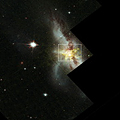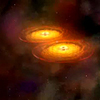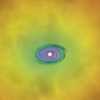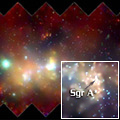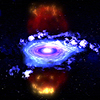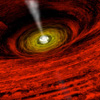1. Sequence of Hubble and Chandra Images of NGC 6240
QuicktimeMPEG Broadcast:
This sequence begins with a wide-field optical image of the galaxy NGC 6240 and then zooms into the central region where it dissolves to a Chandra X-ray image. The colors in the X-ray image show the intensity of the low (red), medium (green) and high (blue) energy X-rays. This image then dissolves to show only the highest-energy X-rays detected by Chandra, which come from gas around the two black holes in the center of the galaxy.
[Runtime: 0:15]
(X-ray: NASA/CXC/MPE/S.Komossa et al.; Optical: NASA/STScI/R.P.van der Marel & J.Gerssen)
Related Chandra Images:
QuicktimeMPEG Broadcast:
- QuickTime movie (uncompressed)
- D1 (0.9 pixel aspect ratio)
- 720x486
- 29.97 fps
- file size = (91.2 MB)
This sequence begins with a wide-field optical image of the galaxy NGC 6240 and then zooms into the central region where it dissolves to a Chandra X-ray image. The colors in the X-ray image show the intensity of the low (red), medium (green) and high (blue) energy X-rays. This image then dissolves to show only the highest-energy X-rays detected by Chandra, which come from gas around the two black holes in the center of the galaxy.
[Runtime: 0:15]
(X-ray: NASA/CXC/MPE/S.Komossa et al.; Optical: NASA/STScI/R.P.van der Marel & J.Gerssen)
Related Chandra Images:
- Photo Album: NGC 6240
2. Black Hole Merger Animation
QuicktimeMPEG Broadcast:
The movie shows a merger of two galaxies (simulation) that forms a single galaxy with two centrally located supermassive black holes surrounded by disks of hot gas. The black holes orbit each other for hundreds of millions of years before they merge to form a single supermassive black hole that sends out intense gravitational waves.
[Runtime: 0:43]
View Stills
(Animation: NASA/CXC/A.Hobart; Simulation: Josh Barnes (U of Hawaii)/John Hibbard (NRAO))
Related Chandra Images:
QuicktimeMPEG Broadcast:
- QuickTime movie (uncompressed)
- D1 (0.9 pixel aspect ratio)
- 720x486
- 29.97 fps
- file size = (441 MB)
The movie shows a merger of two galaxies (simulation) that forms a single galaxy with two centrally located supermassive black holes surrounded by disks of hot gas. The black holes orbit each other for hundreds of millions of years before they merge to form a single supermassive black hole that sends out intense gravitational waves.
[Runtime: 0:43]
View Stills
(Animation: NASA/CXC/A.Hobart; Simulation: Josh Barnes (U of Hawaii)/John Hibbard (NRAO))
Related Chandra Images:
- Photo Album: NGC 6240
3. Animation of Black Hole with Accretion Disk and Torus
QuicktimeMPEG Broadcast:
This artist's conception shows a black hole system in each of its constituent parts as viewed from the top. First, the image shows the black hole itself, then a disk of hot gas surrounding the black hole, and, finally a large doughnut (or torus) of cooler gas and dust enshrouding the system. Next, this artist's conception shows the black hole as viewed edge-on, surrounded by the disk of hot gas, and the large torus of cooler gas and dust. This animation shows why X-rays are crucial in understanding the nature of these black hole systems. Unlike optical emission, X-rays can penetrate the torus of gas and dust that enshrouds the black hole, and therefore reveals information about the central object which is otherwise hidden.
[Runtime: 0:16]
(CXC/M.Weiss & A.Hobart)
QuicktimeMPEG Broadcast:
- QuickTime movie (uncompressed)
- D1 (0.9 pixel aspect ratio)
- 720x486
- 29.97 fps
- file size = (109.5 MB)
This artist's conception shows a black hole system in each of its constituent parts as viewed from the top. First, the image shows the black hole itself, then a disk of hot gas surrounding the black hole, and, finally a large doughnut (or torus) of cooler gas and dust enshrouding the system. Next, this artist's conception shows the black hole as viewed edge-on, surrounded by the disk of hot gas, and the large torus of cooler gas and dust. This animation shows why X-rays are crucial in understanding the nature of these black hole systems. Unlike optical emission, X-rays can penetrate the torus of gas and dust that enshrouds the black hole, and therefore reveals information about the central object which is otherwise hidden.
[Runtime: 0:16]
(CXC/M.Weiss & A.Hobart)
4. Sequence of Chandra Images of Galactic Center & Sgr A*
QuicktimeMPEG This sequence begins with a 400 by 900 light-year mosaic of several Chandra images of the central region of our Galaxy that reveals hundreds of white dwarf stars, neutron stars, and black holes bathed in an incandescent fog of multimillion-degree gas. The mosaic then zooms into a large region around the supermassive black hole at our Galaxy's center, a.k.a. Sagittarius A* or Sgr A*. Marked in this field around Sgr A* are two newly discovered large lobes of multimillion-degree gas that extend for dozens of light years on either side of the black hole. The final Chandra image in this sequence is a close-up of the location of the supermassive black hole Sgr A* and an X-ray jet. This suspected jet is 1.5 light years in length and is due to high-energy particles ejected from the vicinity of the black hole.
[Runtime: 0:22]
(Galactic Center (Survey): NASA/UMass/D.Wang et al., Sgr A* (3-color & close-up): NASA/CXC/MIT/F.K.Baganoff et al.)
Related Chandra Images:
QuicktimeMPEG This sequence begins with a 400 by 900 light-year mosaic of several Chandra images of the central region of our Galaxy that reveals hundreds of white dwarf stars, neutron stars, and black holes bathed in an incandescent fog of multimillion-degree gas. The mosaic then zooms into a large region around the supermassive black hole at our Galaxy's center, a.k.a. Sagittarius A* or Sgr A*. Marked in this field around Sgr A* are two newly discovered large lobes of multimillion-degree gas that extend for dozens of light years on either side of the black hole. The final Chandra image in this sequence is a close-up of the location of the supermassive black hole Sgr A* and an X-ray jet. This suspected jet is 1.5 light years in length and is due to high-energy particles ejected from the vicinity of the black hole.
[Runtime: 0:22]
(Galactic Center (Survey): NASA/UMass/D.Wang et al., Sgr A* (3-color & close-up): NASA/CXC/MIT/F.K.Baganoff et al.)
Related Chandra Images:
- Photo Album: Sagittarius A*
5. Black Hole Flare Animation
QuicktimeMPEG Broadcast:
This sequence begins with a 600,000-second exposure of Sgr A* made with NASA's Chandra X-ray Observatory. Next, it zooms into the precise location of the central supermassive hole, and then dissolves into an artist's rendition of the system. This illustrates how high-energy particles and X-ray flares are produced when matter falls onto the accretion disk around a supermassive black hole.
[Runtime: 0:22]
View Stills
(NASA/SAO/CXC/D.Berry)
Related Chandra Images:
QuicktimeMPEG Broadcast:
- QuickTime movie (uncompressed)
- D1 (0.9 pixel aspect ratio)
- 720x486
- 29.97 fps
- file size = (248.1 MB)
This sequence begins with a 600,000-second exposure of Sgr A* made with NASA's Chandra X-ray Observatory. Next, it zooms into the precise location of the central supermassive hole, and then dissolves into an artist's rendition of the system. This illustrates how high-energy particles and X-ray flares are produced when matter falls onto the accretion disk around a supermassive black hole.
[Runtime: 0:22]
View Stills
(NASA/SAO/CXC/D.Berry)
Related Chandra Images:
- Photo Album: Sagittarius A*
6. Black Hole Animation
QuicktimeMPEG Broadcast:
This animation illustrates the activity surrounding a black hole. While the matter that has passed the black hole's "event horizon" can't be seen, material swirling outside this threshold is accelerated to millions of degrees and radiates in X-rays. At the end of the animation, the black hole is shown shrouded in a cloud of gas and dust, obscuring it from most angles at wavelengths other than the X-rays picked up by the Chandra X-ray Observatory.
[Runtime: 0:27]
View Stills
(NASA/CXC/A.Hobart)
QuicktimeMPEG Broadcast:
- QuickTime movie (uncompressed)
- D1 (0.9 pixel aspect ratio)
- 720x486
- 29.97 fps
- file size = (460.6 MB)
This animation illustrates the activity surrounding a black hole. While the matter that has passed the black hole's "event horizon" can't be seen, material swirling outside this threshold is accelerated to millions of degrees and radiates in X-rays. At the end of the animation, the black hole is shown shrouded in a cloud of gas and dust, obscuring it from most angles at wavelengths other than the X-rays picked up by the Chandra X-ray Observatory.
[Runtime: 0:27]
View Stills
(NASA/CXC/A.Hobart)


